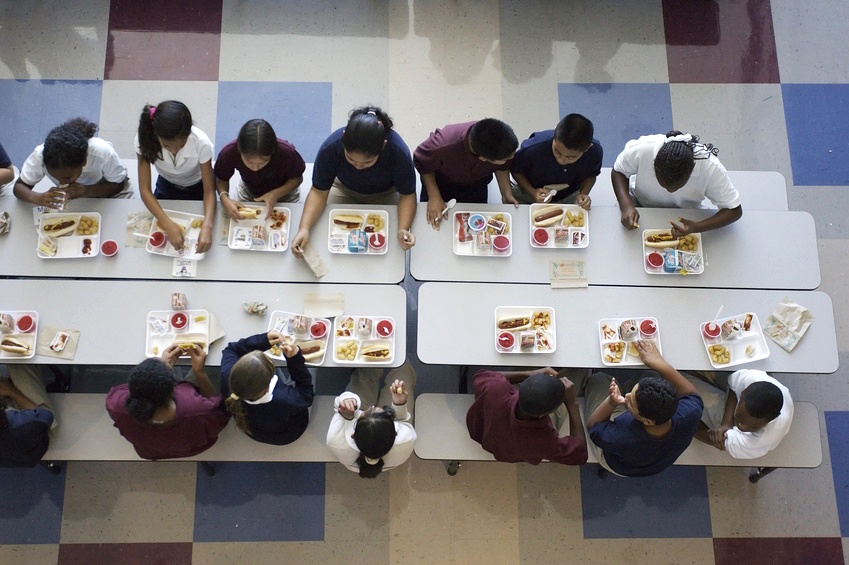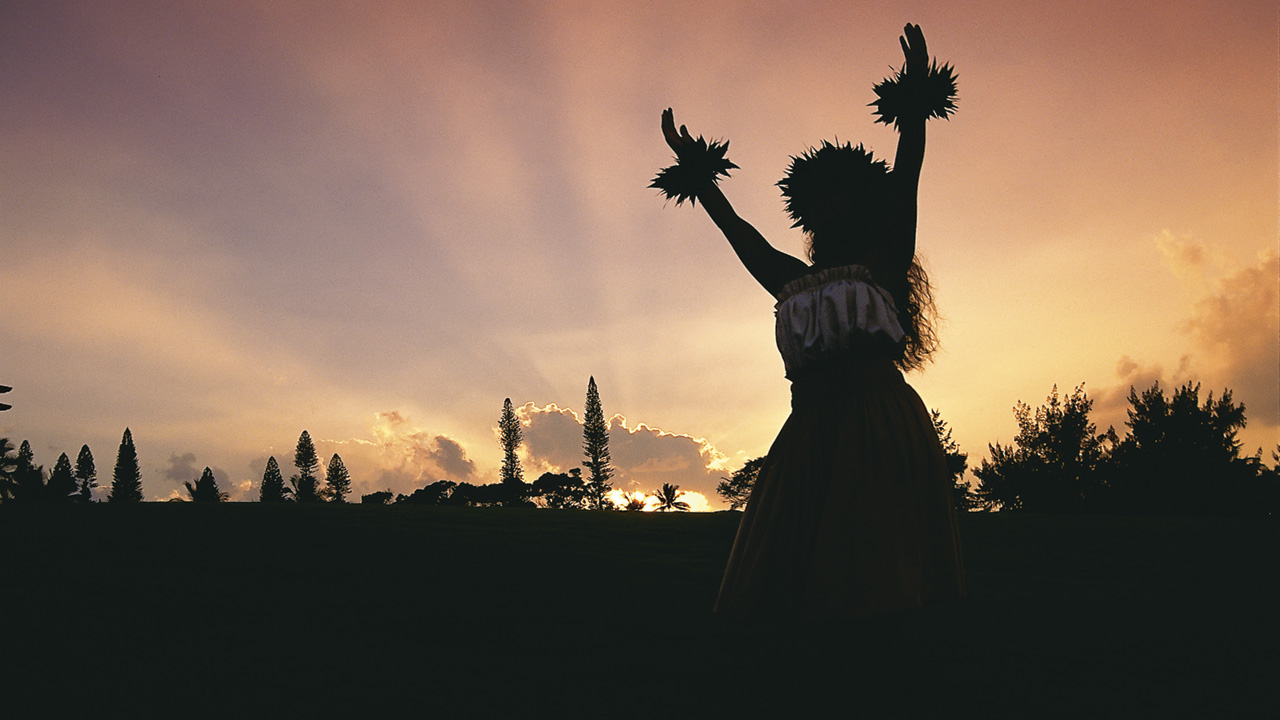MARIANI’S
Virtual Gourmet
April
19, 2015
NEWSLETTER
IN THIS ISSUE
EATING, SLEEPING, SURFING
AND ZONING OUT ON MAUI
By Misha Mariani
NEW YORK CORNER
A VOCE
By John Mariani
NOTES FROM THE WINE CELLAR
HENNESSY COGNAC'S TASTING PANEL
By Mort Hochstein
❖❖❖
EATING,
SLEEPING, SURFING
AND ZONING OUT ON MAUI
By Misha Mariani
We
were moving on to the west side of the
island of Maui, to Kapalua and Lahaina, but before
we settled in there, we had
a day to kill and took a drive just a little
northeast of Wailea to Paia, a
wonderfully quaint town that has long been one of
the top tourists draws on the
island. But to my happy surprise, Paia has gone
virtually unchanged and
uninfluenced by the tourist demand and remains one
of the great local towns of
the island.
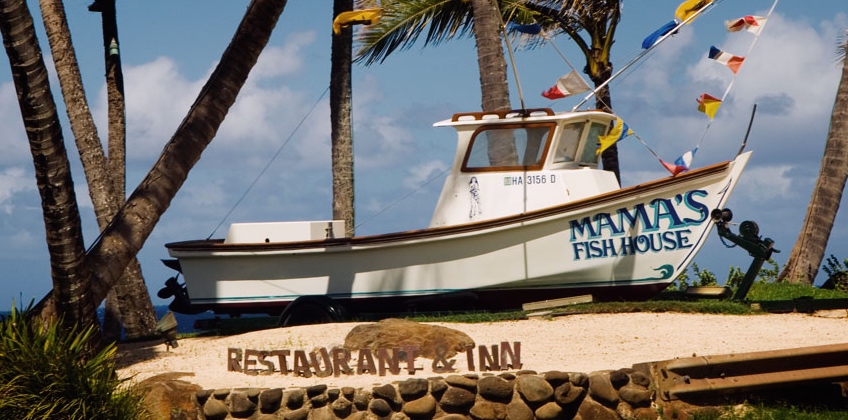 Located just
outside the center of town is a restaurant called Mama’s Fish House,
which was
established by the Christenson family in 1973, after
taking a sailing trip
across the South Pacific. The Christensons fell
madly in love with the
Polynesian lifestyle, so they opened a restaurant
and dedicated themselves to
providing true Polynesian cuisine, drawing all their
ingredients and fish from
local purveyors. This has been and continues to be
their proven business model.
They are not in business just to service their
guests and to provide great food
and genuine top-notch hospitality, they are in
business to service their
community and to help improve business all around
them.
Located just
outside the center of town is a restaurant called Mama’s Fish House,
which was
established by the Christenson family in 1973, after
taking a sailing trip
across the South Pacific. The Christensons fell
madly in love with the
Polynesian lifestyle, so they opened a restaurant
and dedicated themselves to
providing true Polynesian cuisine, drawing all their
ingredients and fish from
local purveyors. This has been and continues to be
their proven business model.
They are not in business just to service their
guests and to provide great food
and genuine top-notch hospitality, they are in
business to service their
community and to help improve business all around
them.
I learned this upon meeting Karen
Christensen, the founders’ daughter,
who is very much at the helm of the business these
days, and Perry Bateman,
their executive chef.
It has been
quite some time since I sat down with two more
passionate individuals in this
industry. After years and years of being present in
the kitchen and dining
room, these
two still exude a high
level of excitement and enthusiasm for what they do
every day. 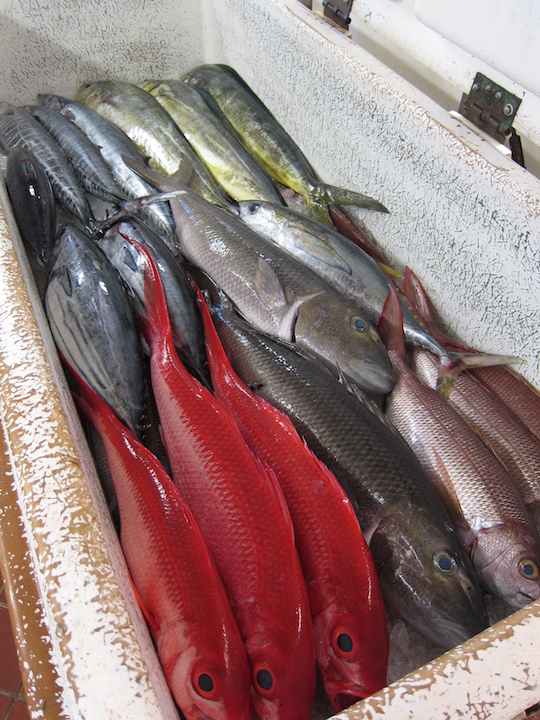 And that is very rare
these days.
And that is very rare
these days.
As
they gave me a tour
of the restaurant and facility, I felt the
commitment and dedication that not
only these two had towards Mama’s but how they
instill it in every one of those
workers I encountered. They guided
me through the hectic kitchen, into the storage
rooms filled with local produce
and ingredients, and finally gave me a close-up look
at their butchering
facilities, which had cooler after cooler of some of
the most beautiful
specimens of Pacific fish culled from more than 200
different fisherman a year:
red snapper, a color of red you can never imagine if
you hadn’t seen for
yourself; silver-skinned
mackerel
that had the sheen of stainless steel; and yellow
fin tuna so fresh it was as
if they were looking right back at you. The last
time I saw fish this beautiful
was at Tsukigi Market in Tokyo.
Mama’s
Fish House's
commitment to local produce and fresh fish goes far
beyond just buying from the
local sources. They have actually funded and
anchored a buoy 30 miles off the
shore of Maui that helps create a habitat for
pelagic species such as tuna,
mahi mahi, ono, and billfish, as well as helping to
bring the fishing community
together by creating a level of sustainability. It's
an effort of giving back
to the community that you see very rarely by
privately owned business.
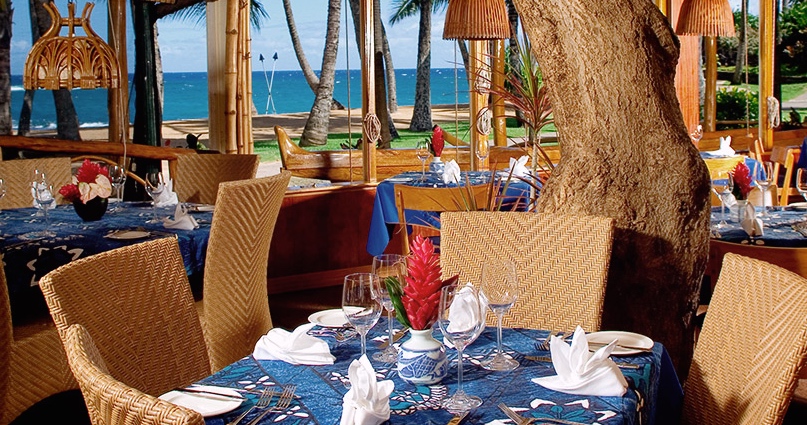 Mama’s
resides on a
beach front about 100 yards off the water’s edge,
where from many of the tables
you can stare out to the blue waters and crashing
waves as you sip your mai tai
or glass of wine and enjoy their exceptional
cuisine. The design of the
restaurant has stayed true to the traditional
Polynesian influence that defines
everything at Mama’s. Dark woods, Polynesian
artifacts, colorfully design
tablecloths, an abundance of gorgeous orchids,
servers in Polynesian patterned
dresses and shirts, and nautical objects set the
ambiance in the casual
setting. It’s
very popular with
tourists, but I found the food here was as delicious
as any I had anywhere in
Hawaii.
Mama’s
resides on a
beach front about 100 yards off the water’s edge,
where from many of the tables
you can stare out to the blue waters and crashing
waves as you sip your mai tai
or glass of wine and enjoy their exceptional
cuisine. The design of the
restaurant has stayed true to the traditional
Polynesian influence that defines
everything at Mama’s. Dark woods, Polynesian
artifacts, colorfully design
tablecloths, an abundance of gorgeous orchids,
servers in Polynesian patterned
dresses and shirts, and nautical objects set the
ambiance in the casual
setting. It’s
very popular with
tourists, but I found the food here was as delicious
as any I had anywhere in
Hawaii.
When we sat down for lunch, we started off
with cocktails, then settled
in and let Chef Bateman do the choosing and cooking.
We began with a trio of
sashimi ($28-$50), ono, onaga and ahi, each prepared
differently. The ono
with Finger Limes, Hawaiian sea salt and green miso
greens was bright,
refreshing and delicious; Onaga
(local red snapper) with black sea salt, Hawaiian
chili and passion 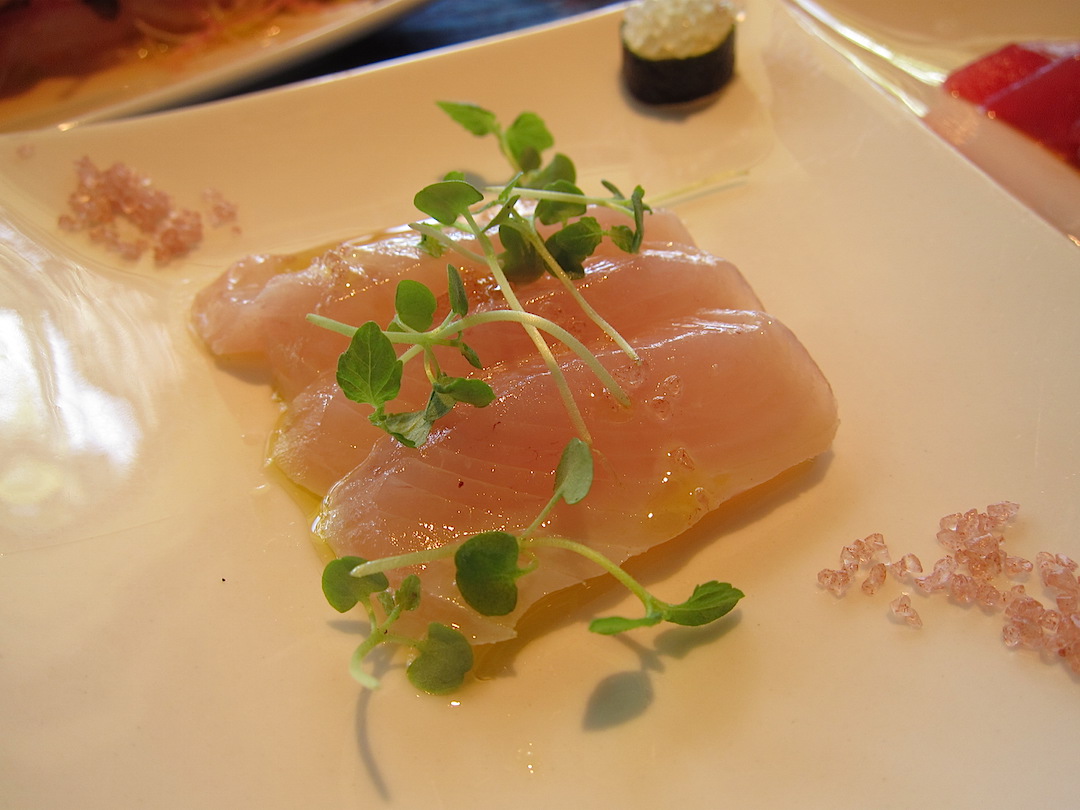 fruit had
just the right balance of heat, saltiness and sour
from the passion fruit to
complement the sweetness of the flesh;
and the ahi, rich and fatty, was cut with
ponzu and highlighted with
fresh miso greens.
fruit had
just the right balance of heat, saltiness and sour
from the passion fruit to
complement the sweetness of the flesh;
and the ahi, rich and fatty, was cut with
ponzu and highlighted with
fresh miso greens.
An
exceptional starter
was the octopus ($24), grilled and served with sweet
daikon and bitter, crisp
watermelon radish, balanced with sweet kalamanzi
citrus. A must-not-miss is the
opakapaka collar
($50). Opakapaka
is a pink snapper with sweet, delicate white flesh, here fried and served with a
traditional dipping sauce of
chili, scallion, soy, lime and pickled cucumbers (below). If this
was the only thing I
could have eaten all day, I would have been a very
happy man.
For
entrees, there was onaga ($48), a red snapper
steamed and served in a flavorful
broth with snow peas and fried ginger, and ahi tuna
($46), which is crusted in
a ginger and sesame seed panic and served with a
kale pig-fried rice.
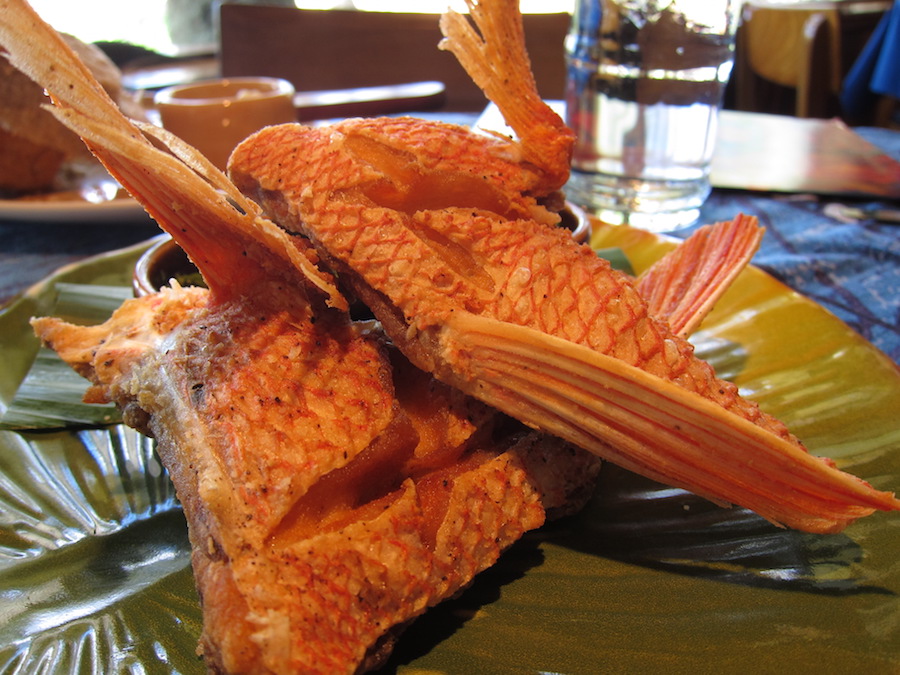 After
our lunch, feeling
filled and satisfied, we hopped back into our car
and headed out to the west
coast of the island towards Kapalua, traveling
Highway 30 on the coastline that
ripples along the Pacific and watching the locals
surf the five-foot swells as
if it was part of their daily routine. We neared
Kapalua, driving past the very
colorful town of Lahaina, on our way to the Ritz Carlton,
which is certainly at
the luxury high end of Maui’s resorts. You feel that
immediately upon pulling
up to the entrance way. The property sits directly
on the coast, like many of
the other top resorts here on the island, but unlike
others, The Ritz Carlton
also overlooks two
PGA
Championship golf course--the
Plantation
Course and the Bay Course, with 16 of its 18 holes overlooking the
ocean. (These courses used to be an
historic pineapple plantation,
but the industry collapsed in the 1960s, with both
Dole and Del Monte moving
their production out of the islands in 2008.)
After
our lunch, feeling
filled and satisfied, we hopped back into our car
and headed out to the west
coast of the island towards Kapalua, traveling
Highway 30 on the coastline that
ripples along the Pacific and watching the locals
surf the five-foot swells as
if it was part of their daily routine. We neared
Kapalua, driving past the very
colorful town of Lahaina, on our way to the Ritz Carlton,
which is certainly at
the luxury high end of Maui’s resorts. You feel that
immediately upon pulling
up to the entrance way. The property sits directly
on the coast, like many of
the other top resorts here on the island, but unlike
others, The Ritz Carlton
also overlooks two
PGA
Championship golf course--the
Plantation
Course and the Bay Course, with 16 of its 18 holes overlooking the
ocean. (These courses used to be an
historic pineapple plantation,
but the industry collapsed in the 1960s, with both
Dole and Del Monte moving
their production out of the islands in 2008.)
The
hotel is U-shaped
with a multi-tiered pool facility that gradually
slopes down and provides
separation in the different wading pools.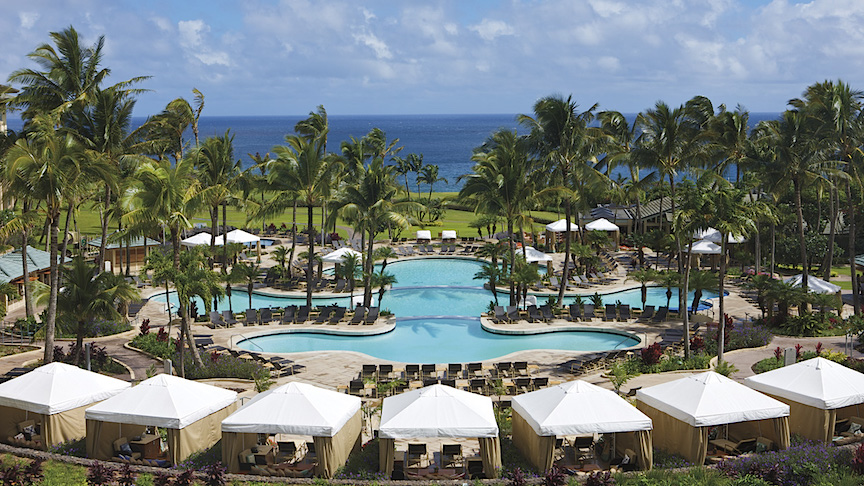 There is full food and
beverage service
provided at all locations poolside, as well as a
tiki bar towards the bottom
and more comprehensive full service bar up towards
the main portion of the
resort, where lunch and drinks can be had at your
leisure. Private cabanas are
also available, which we spoiled ourselves in, with
a full service staff,
privacy, couches, television and other great
amenities.
There is full food and
beverage service
provided at all locations poolside, as well as a
tiki bar towards the bottom
and more comprehensive full service bar up towards
the main portion of the
resort, where lunch and drinks can be had at your
leisure. Private cabanas are
also available, which we spoiled ourselves in, with
a full service staff,
privacy, couches, television and other great
amenities.
There
is wide variety
among the resort’s 436 rooms, some with Club Level
accommodations, but I
recommend the Ocean Front Suite. Upon entering, your
first introduction into
this lap of luxury is a foyer quickly opening on a
glorious living room of
hardwood floors, plush and elegantly designed
furniture, warm beige walls and
softly lit lamps. Two swinging doors give entrance
to an expansive bedroom with
a king-size bed. There is a mahogany coffee table, a
large HD television, a
powder room and sliding doors that lead you out to
your own private terrace
overlooking an ocean not more that 200 yards away—a
pretty impressive spot from
which to watch sunsets.
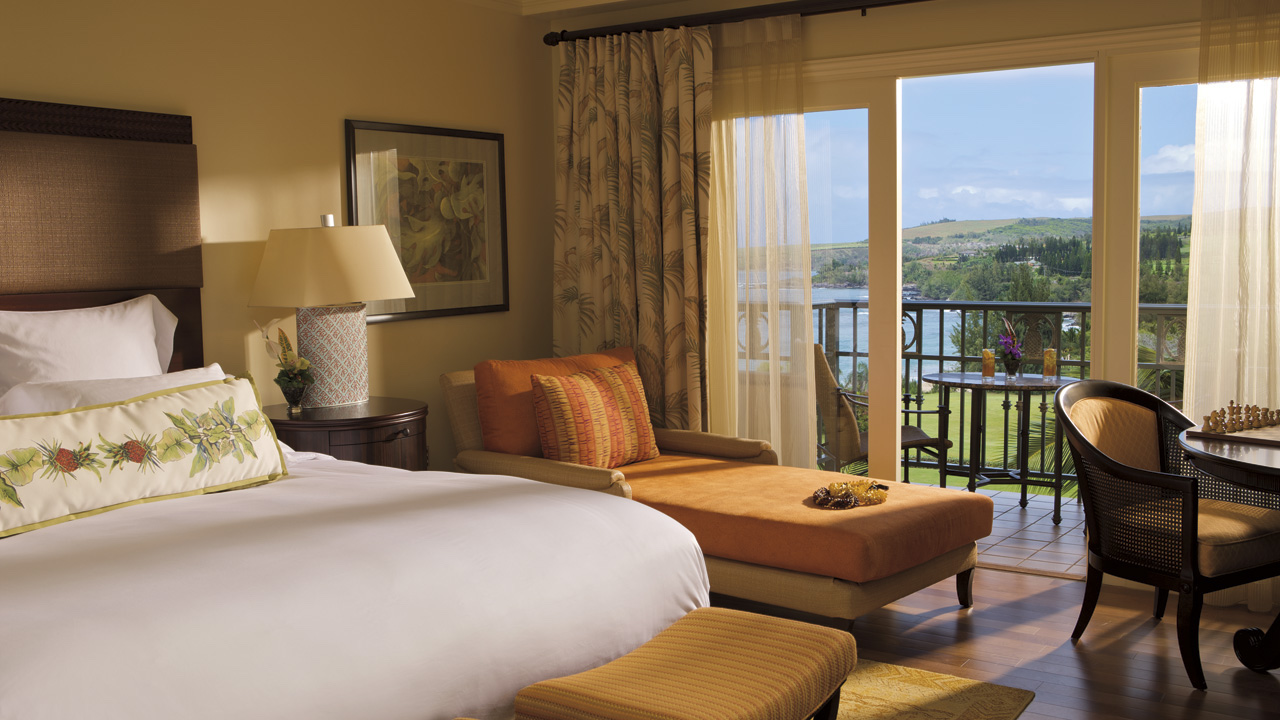 After
we’d had that peek
at the surfers catching waves on our way into
Kapalua, I determined that the
next day my wife and I were going to take surfing
lessons. Being an avid
snowboarder and having lived in Colorado for a year
to teach the sport many
moons ago, I had always wanted to try surfing.
Within minutes the recreation
desk scheduled a lesson for the next day with a surf
school company called
Rivers to the Sea.
After
we’d had that peek
at the surfers catching waves on our way into
Kapalua, I determined that the
next day my wife and I were going to take surfing
lessons. Being an avid
snowboarder and having lived in Colorado for a year
to teach the sport many
moons ago, I had always wanted to try surfing.
Within minutes the recreation
desk scheduled a lesson for the next day with a surf
school company called
Rivers to the Sea.
We
woke up the next
morning, grabbed a coffee and a bagel at the
resort’s Aina
Gourmet coffee
shop--which became our favorite breakfast
spot for the next few days--then
headed back out to Highway 30, where we met up with
our teacher at a specific
mile marker. After a quick tutorial and a few
beachside practice leaps up onto
the board, we headed out into the ocean to catch our
first waves. Of course,
the first few attempts landed us flat in the water
as the waves rolled over us.
But, after a
couple of tries,
both of us were up and surfing,
spending the next hour paddling out into the surf
and riding the waves back in,
working our bodies to the point that it was
mandatory that we take full
advantage of The Ritz Carlton’s Spa and massage
treatment that afternoon. Here they say “e malama kou kino,”
which
translates to “care for your body.”
As
with everything else
at The Ritz Carlton, the options are endless at the
spa, with even special Spa
Wedding Packages that require anywhere from two to
five hours of devotion and
plenty of options ranging from facials, pedicures,
couple massages, 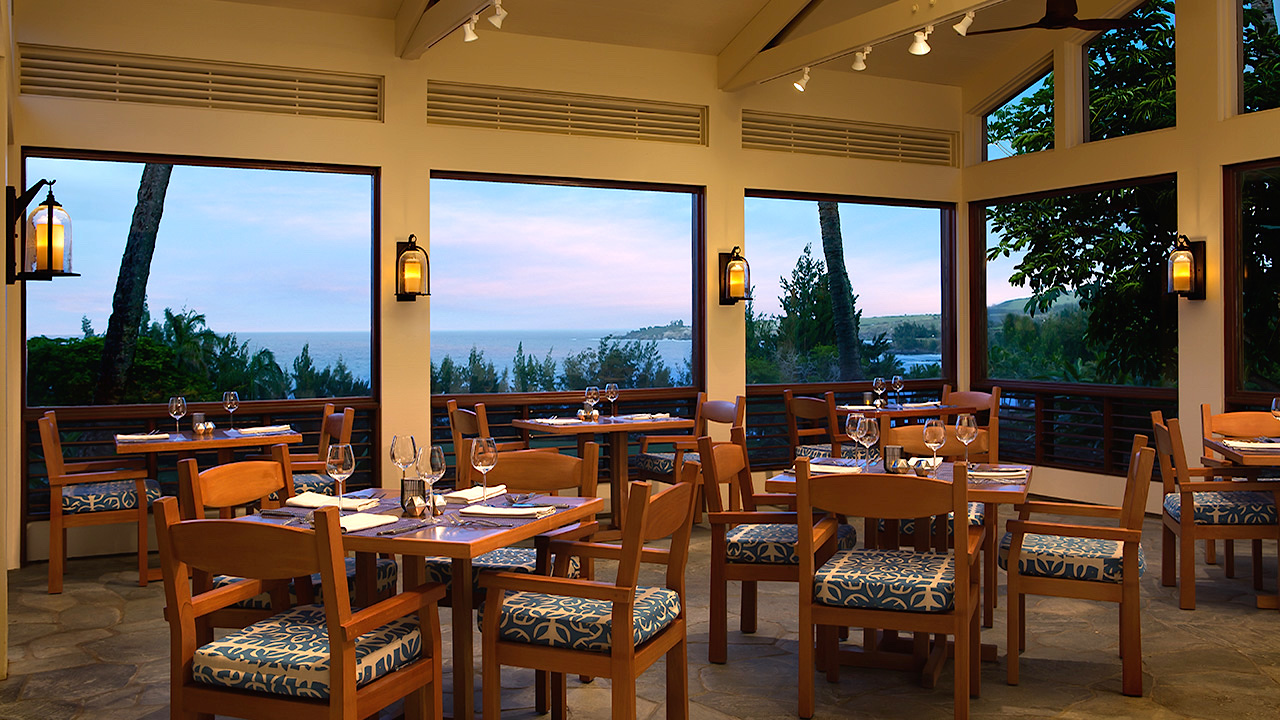 hot stone
treatment and more.
hot stone
treatment and more.
The
Ritz Carlton has a
number of dining options, ranging from more casual
dining, such as The
Beach
House restaurant, to Kai
Sushi and the more refined and formal
experience that is The
Banyan Tree (right), which
is putting out some very creative and delicious
cuisine that takes influence
from a number of cultures. We had the opportunity to
try dishes such as the
warm grilled housemade ricotta with preserved lemon,
almond and local honey,
which sang with flavors of richness, sweetness and
balancing tartness from the
lemon. Another standout was the Banyan Bouillabaisse
with scallops, shrimp, and
sea bass in a lemongrass lobster broth.
It’s remarkable how an ocean breeze can
improve the flavor of everything
fresh to begin with.
Indeed, the ocean improves just
about everything on Maui, and it’s difficult not to
just chill out for the
duration of one’s stay. But then
you’d miss one of Hawaii’s
largest
nature preserves and two marine sanctuaries, perhaps
the Celebration of
the Arts Festival, the Kapalua Wine & Food
Festival or the
PGA Tour’s Hyundai Tournament of
Champions, depending on when you visit.
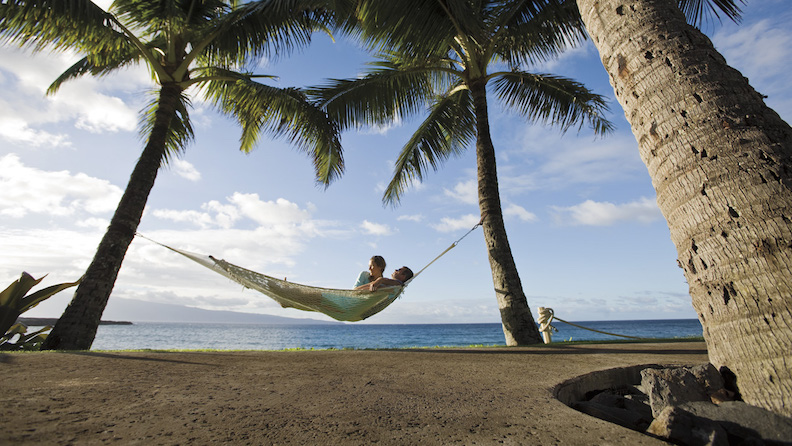
By John Mariani
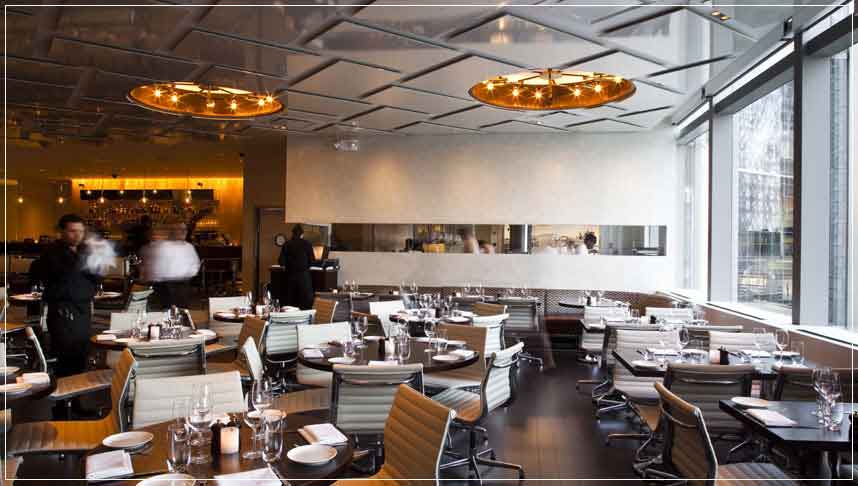 a voce
a voce10 Columbus Circle
212-823-25623
avocerestaurant.com/columbus
When it opened in
2003, no one knew for sure if putting a bunch
of restaurants on the third and fourth floors
of the Time-Warner Center at Columbus Circle
was going to be a good idea. A lot
of experienced restaurateurs wondered if
people--especially New Yorkers--would be
caught dead taking an escalator up to a dining
room.
But,
aside from a couple of ill-advised, short-lived
restaurants, the Center has proven an enormous
success for places like Per Se, Porter House,
Masa, and A Voce, which was opened in 2009 by
London-based Marlon Abela Restaurant Corp. (There
is also a downtown A Voce.)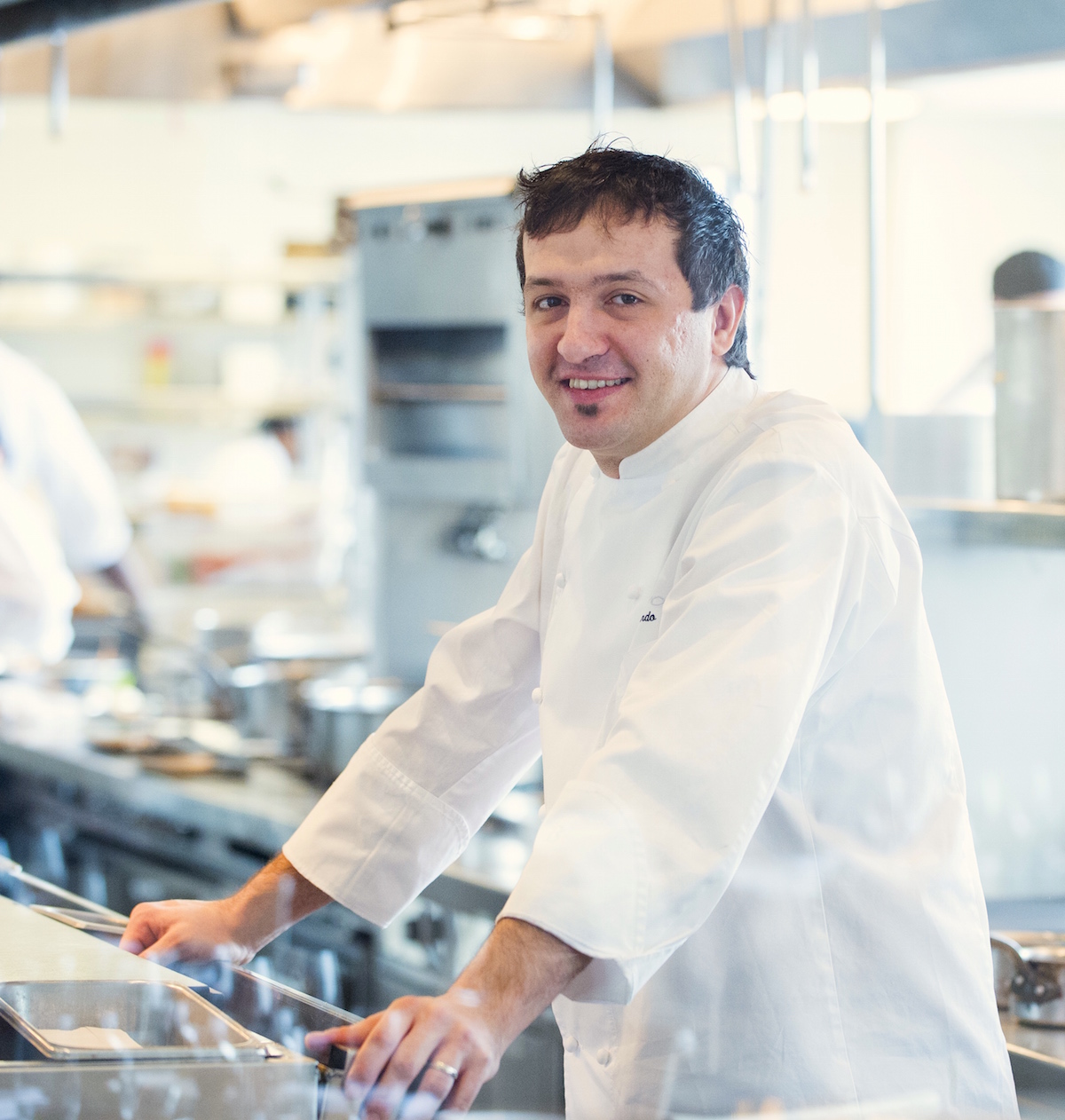
Its location has never been a
problem with: a) people who work in the building,
b) those who stay next door at the
Mandarin-Oriental or in the hotels that line
Central Park South, c) those who love the panorama
over Columbus Circle of Central Park, d) Broadway
theater and Lincoln Center goers, and e) those who
love stylish Italian cuisine. Good
mix indeed.
So the bar is always packed by
six o'clock, the tables full by eight, and all
those people make a lot of noise in an interior
that is very handsome in a sort of Milanese modern
way but devoid of any textures to soak up the
sound. The
Rockwell Group has designed the space to be both
sexy and romantic
enough for those in thrall to the city’s lights,
but businessmen and women feel comfortable coming
here just for a plate of pasta and glass of wine
after work.
There is also private dining available. The
colors of ivory and brown and glass walls lined
with 7,500 bottles from an 800-label
list--overseen by Olivier Flosse--provide a
contrast of cool and glistening surfaces.
There has
been some turnover in chefs in the past couple of
years, but the kitchen is now under Chef Riccardo
Bilotta (right),
born in Trieste, with training and experience in
diverse kitchens that include Il
Pellicano in Porto Ercole, Italy, El Cellar de Can
Roca in Girona, Spain, and most recently Harvest
on Hudson in New York, where he served as
executive chef.
Whereas in the past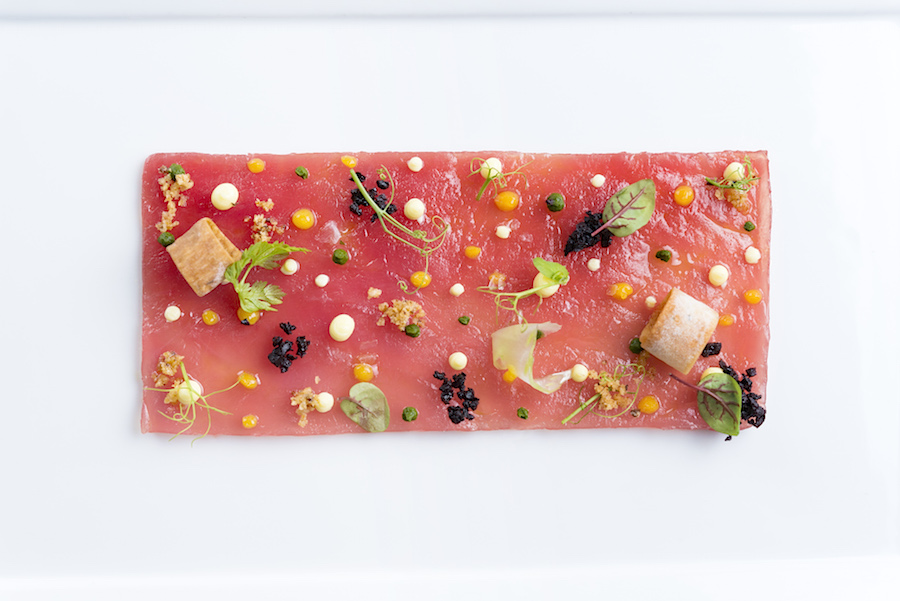 A Voce had
a reputation for modern but lusty flavors, Bilotta
has added just enough refinement to recipes that
incorporate first-rate American ingredients, so as
to make the evolution of the kitchen both clear
and very much his own. Thus, I just abandoned the
menu and let him feed me and my guests on a recent
evening.
A Voce had
a reputation for modern but lusty flavors, Bilotta
has added just enough refinement to recipes that
incorporate first-rate American ingredients, so as
to make the evolution of the kitchen both clear
and very much his own. Thus, I just abandoned the
menu and let him feed me and my guests on a recent
evening.
Quite clearly Bilotta adores seafood, as he should for a chef from Trieste, and I think he’s going one on one with Marea across the street. Our next course was fresh cod with impeccably rendered artichoke purée, pearl onions, black breadcrumbs, and watermelon radish; halibut swam in a heady seafood casserole with meaty borlotti beans and cauliflower.
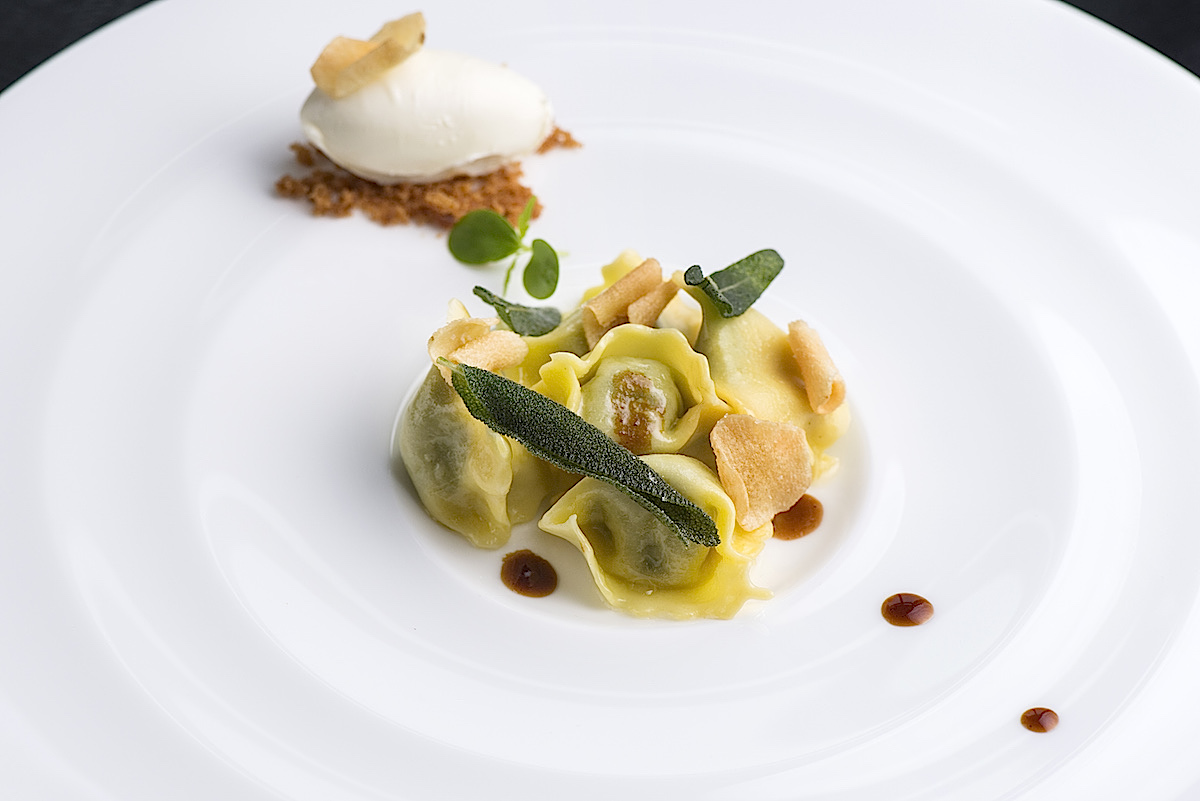 The single meat
dish was an herb-crusted rack of lamb with buttery
potato terrine, lamb cotechino sausage, and an
enchanting pink lady apple mostarda. With
this we enjoyed a Schioppettino, Ronchi di Chialla 2009,
which we sipped for a while before having
desserts.
The single meat
dish was an herb-crusted rack of lamb with buttery
potato terrine, lamb cotechino sausage, and an
enchanting pink lady apple mostarda. With
this we enjoyed a Schioppettino, Ronchi di Chialla 2009,
which we sipped for a while before having
desserts.
Chocolate
and Sicilian pistachio mousse was blended with
olive oil and set with pistachio gelato, while a
coconut semifreddo
came with caramelized pineapple and passion fruit
sorbet.
Even sated we could not resist a bite
of bombolini
with a chocolate hazelnut fonduta and
sprinkling
of Maldon salt.
This is clearly sophisticated
Italian food and, although there were a few people
at other tables ordering just a plate of pasta,
most guests that night were in full swing, with
good bottles of wine on every table. In any
other city A Voce would be very much a special
occasion place, but in NYC it’s a restaurant
people will go to simply for the love of it
whenever they get the chance.
A Voce is open for lunch Mon.-Sat.
and for dinner nightly; brunch on Sun.
❖❖❖
AT HENNESSY, COGNAC CONSISTENCY
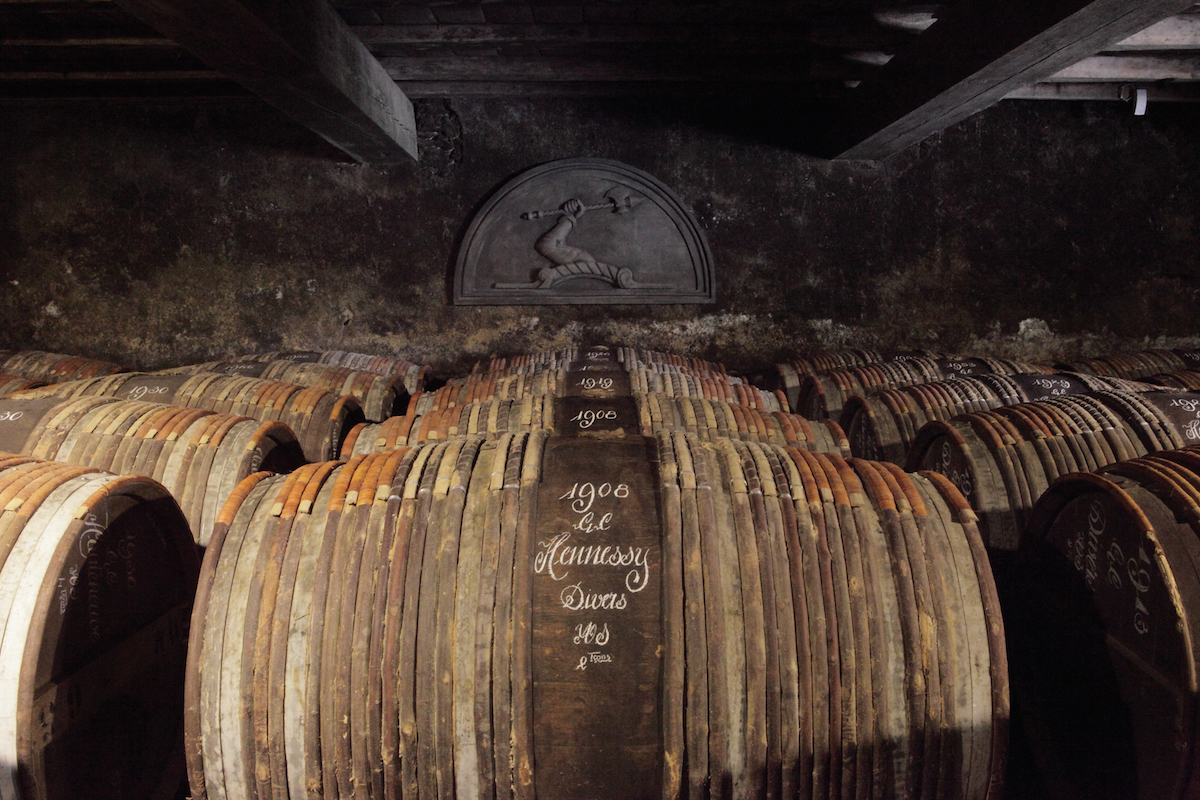
COMES FROM TASTING
AND TASTING
AND TASTING
SOME MORE
By Mort Hochstein
They’ve been tasting cognac this
way for a couple of centuries at Hennessy
Cognac.
Five days a week,
at precisely 11 a.m., six men in coats and ties
sit around a table behind closed doors in a room
along the banks of the River Charente in
southwestern France. Sharing one glass, they sniff
and sample eau de vie, the spirit that is
magically transformed into the region’s most
distinctive product, Cognac. They evaluate aroma,
color and flavor, making judgments on developments
in the wine that may not take effect for decades,
even into the next century.
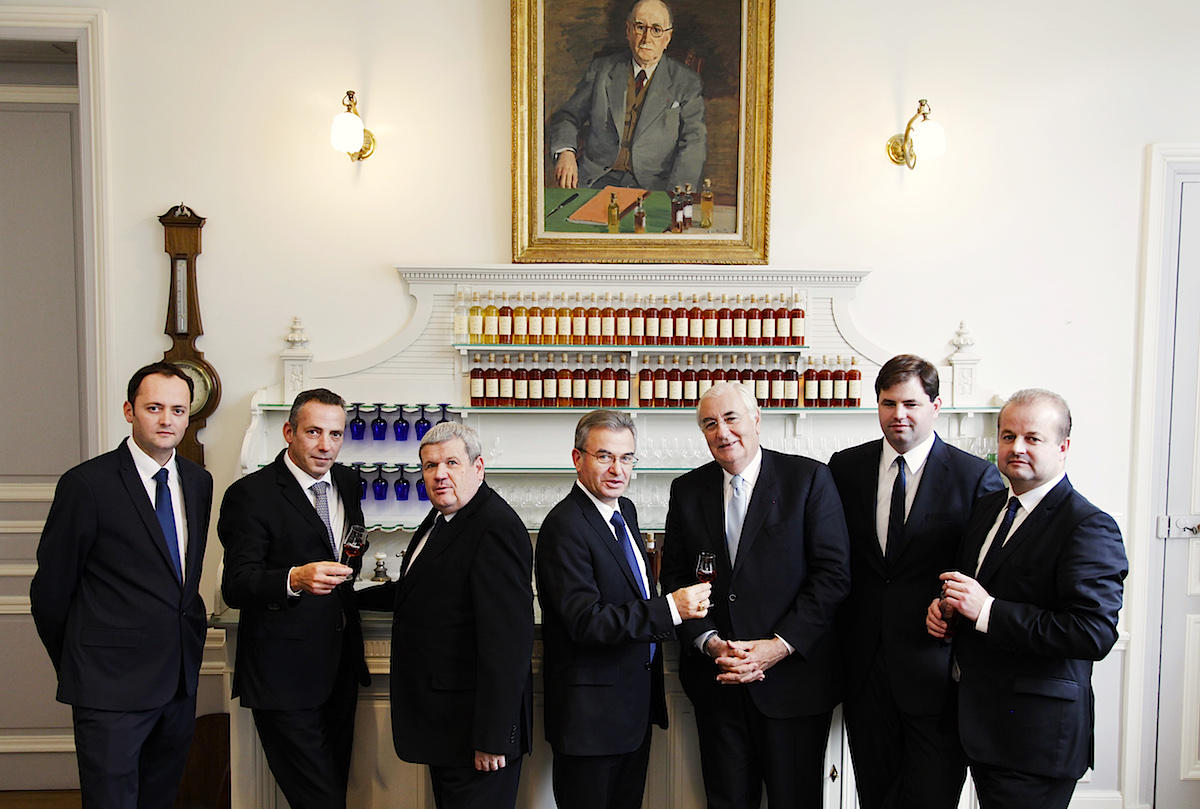 Cognac
relies on tasting and blending skills that take
years to master and little about the ritual has
changed since the firm was founded in 1765.
Renaud di Gironde is one of that select group,
known within Maison Hennessy as the Comité de
Gustation (left).
He likens the daily ritual to a religious
observance: ”We are the guardians of a temple
charged with maintaining the standards established
by Richard Hennessy.”
Cognac
relies on tasting and blending skills that take
years to master and little about the ritual has
changed since the firm was founded in 1765.
Renaud di Gironde is one of that select group,
known within Maison Hennessy as the Comité de
Gustation (left).
He likens the daily ritual to a religious
observance: ”We are the guardians of a temple
charged with maintaining the standards established
by Richard Hennessy.”
The idea of one tasting glass shared by six
people may sound jarring, but Gironde explains,
“We use the same glass to avoid any variation in
how we evaluate the eaux de vie.” These sacrosanct
sessions determine the potential of the barrel
samples, identifying those ready to be blended and
their role in the several styles of Hennessy
Cognac, and identifying those that may need years
before they go into a blend. The youngest members
of that committee are not permitted to express an
opinion until they have experienced ten years of
these tastings, after which they are presumed to
have acquired the palate and references needed for
authoritative judgment.
Di
Gironde is the nephew of Yann Fillioux (below),
Master Blender and taster for Maison Hennessy.
This is not exactly nepotism; it is more a matter
of tradition and heritage. Richard Hennessy, who
captained an Irish brigade in the army of Louis
XV, chose in 1765 to create a new life producing
Cognac. As the century was ending, Emile Fillioux
joined him in Charente as a barrel cooper,
becoming the first of seven generations of the
Fillioux family to serve Hennessy. The sixth and
possibly the most skillful member of the clan
was Maurice Fillioux, a legendary master
blender who directed production from 1958 to 1991.
A dedicated musician, Fillioux observed of
his craft, “You can’t play a melody as complex as
the composition of a Cognac. You have to master
all the notes.” The ability to understand
the scent of the spirits is vital for a blender
and Maurice Fillioux achieved fame for his
olfactory prowess. In a burst of promotional
excess, marketing people once floated the idea of
insuring Fillioux’s sensitive nose for a million
dollars. Fortunately, that bit of hyperbolic
exuberance never went further. 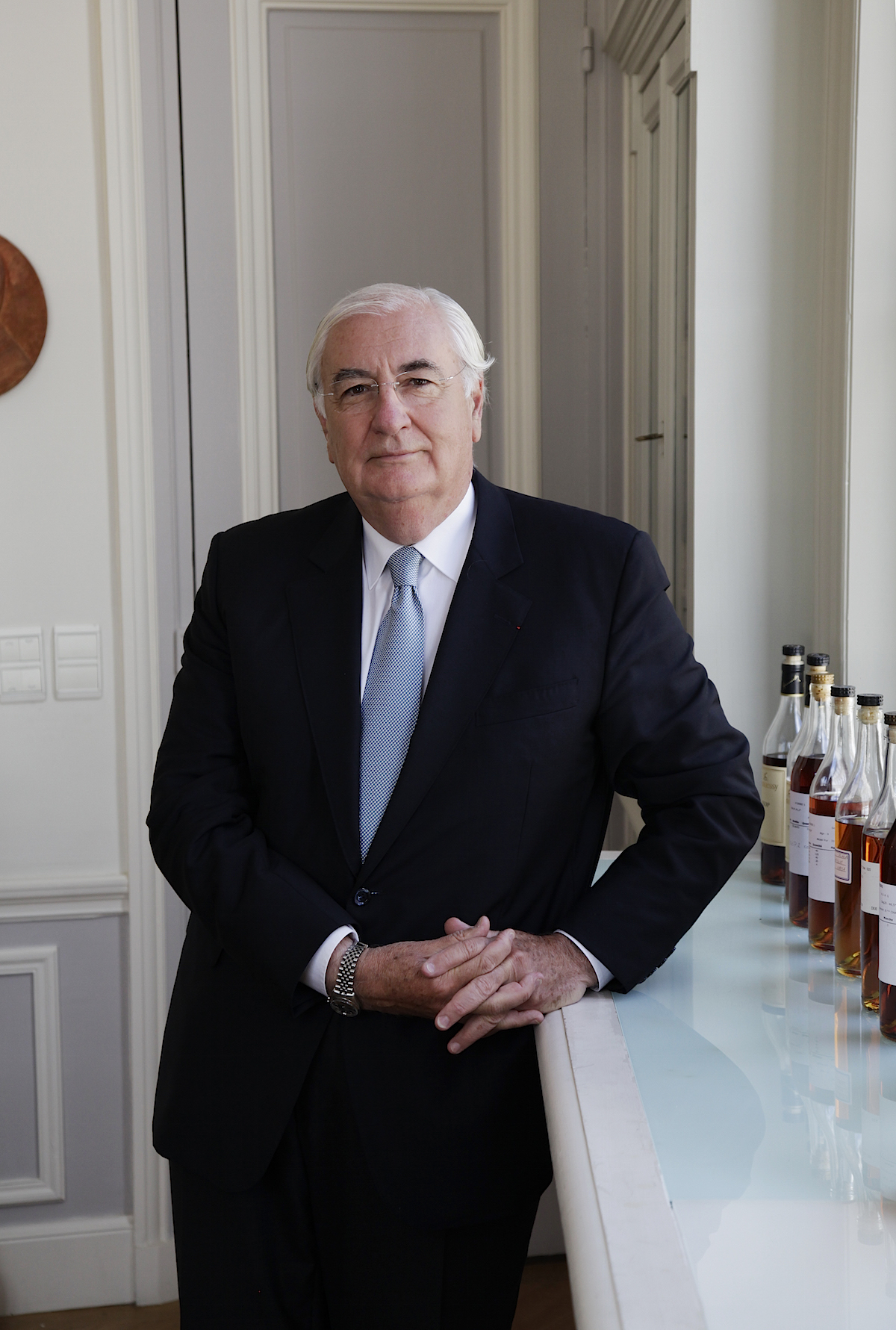
Early on, Renaud di
Gironde thought seriously of joining his uncle as
a taster, but his career took a different turn
after he earned an MBA in Wine Business in
Australia. Gironde is in charge of grower
relations, working with 1,500 farmers who supply
grapes for Hennessy. When not in the vineyards
Gironde relishes his mornings with the tasting
group. “It is,” he says, “an incredible
opportunity to join these elders, with accumulated
centuries of experience, judging 40 to 50 samples
every day.”
The price of Cognac basically depends on
the provenance and age of the youngest
spirits in the blends. Hennessy created a labeling
system still in use in France, classifying his
first Cognac as Three Star, a name later changed
to VS, meaning very special, on the lowest tier of
the Hennessy line. The top standard cognac is XO,
meaning extra old. That flagship brand is composed
of spirits aged for up to 30 years, as opposed to
eight years for VS.
In 1817, another tier came into being when
George IV of England asked for a very superior,
old and pale cognac, meaning one whose color was
not helped by caramel or other agents, giving
birth to the category known as VSOP. Maurice
Hennessy created the XO formula in 1870,
assembling a special blend for a group of friends
and relatives. The price of being a friend today
is about $200 a bottle.
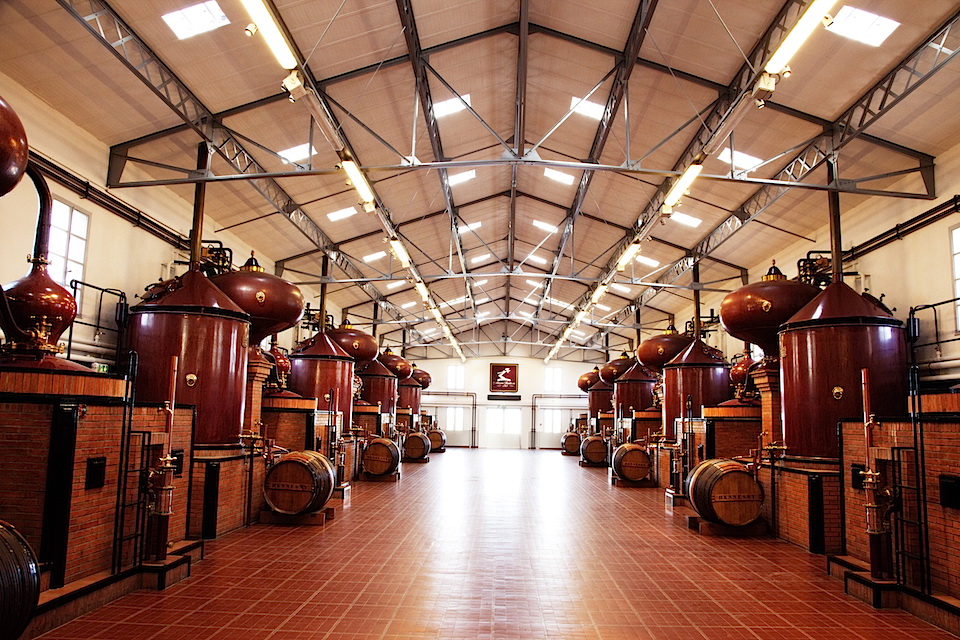 It
is a tradition at Hennessy to celebrate events and
anniversaries with distinctive bottlings,
including the eponymously named Richard Hennessy.
Early in its inception, the firm had developed a
strong following in Russia, whose Empress
Catherine the Great in 1818 placed a special order
to mark the birthday of her son, who became Czar
Alexander I.
It
is a tradition at Hennessy to celebrate events and
anniversaries with distinctive bottlings,
including the eponymously named Richard Hennessy.
Early in its inception, the firm had developed a
strong following in Russia, whose Empress
Catherine the Great in 1818 placed a special order
to mark the birthday of her son, who became Czar
Alexander I.
Just a few years ago, Yann Fillioux
conjured up that original formula , replicating it
as Paradis Imperial, and it was opened publicly
for the first time at lavish ceremonies in the
Hermitage Museum in St. Petersburg. That blend
contains reserves that have slept for as long as
130 years in the oldest of the Maison’s storage
areas, the Founders Cellar. If any can be found,
Paradis commands a price in the neighborhood of
$450.
Yann Fillioux burrowed into those treasured
reserves once again this year to formulate the 250
Collector Blend, commemorating the firm’s 250th
anniversary. This most recent innovation is
described as the crowning achievement of his 50
years at the Maison, and Renaud di Gironde was
dispatched to New York to spearhead a lengthy
promotion campaign. The Hennessy legacy
extends to five continents and Fillioux’s New York
tasting was the opening salvo for a series of
events to be held around the world. Hennessy
advertises this international venture as a hybrid
cultural event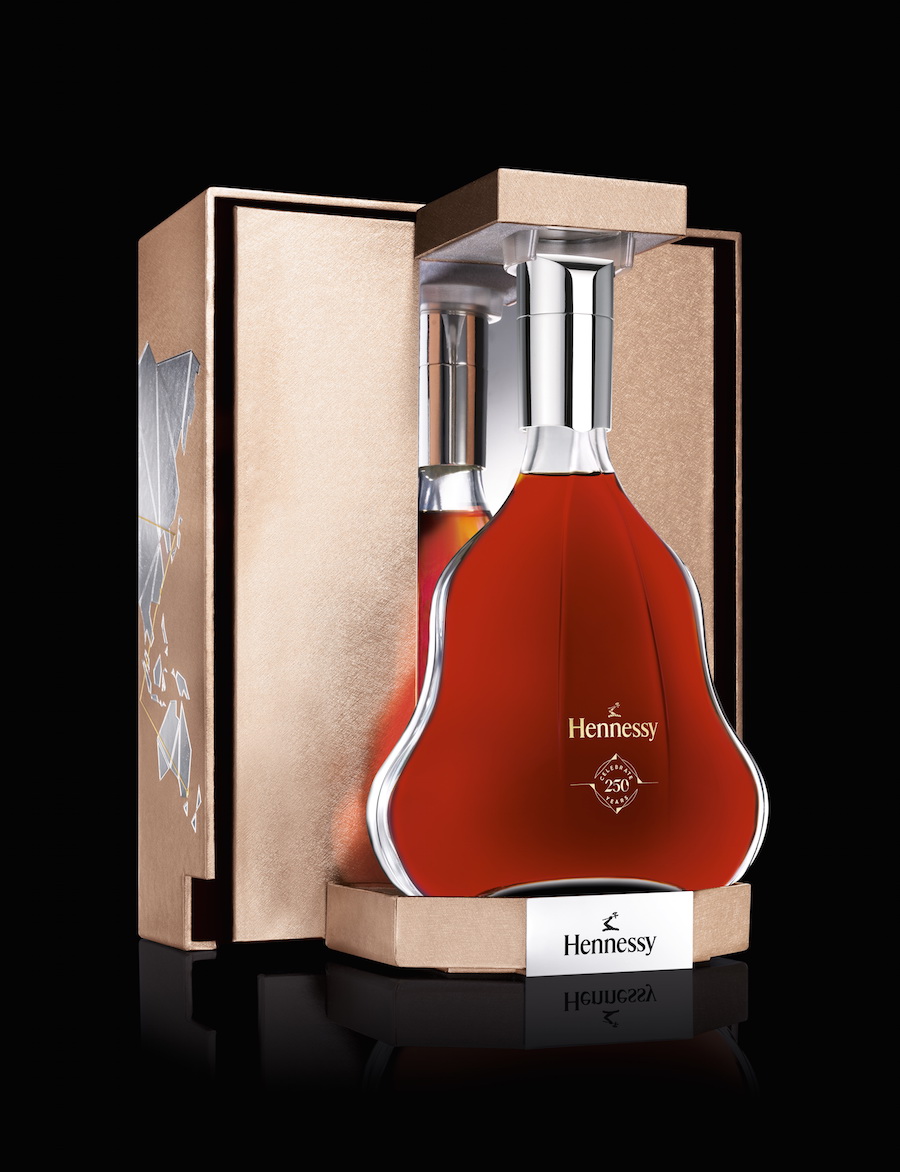 that will
showcase the history of the house and future of
the brand. Buyers and Cognac devotees in key
markets will be exposed to work by contemporary
artists, and iconic posters, advertisements and
documents from the Hennessy library as well as
musical events ranging from classical to rock and
hip hop. “We have made a limited amount of this
anniversary blend and much is already spoken for,
so a little has to go a long way, ” di Gironde
commented as he poured minuscule samples for a
small group of journalists recently. He did not
offer seconds.
that will
showcase the history of the house and future of
the brand. Buyers and Cognac devotees in key
markets will be exposed to work by contemporary
artists, and iconic posters, advertisements and
documents from the Hennessy library as well as
musical events ranging from classical to rock and
hip hop. “We have made a limited amount of this
anniversary blend and much is already spoken for,
so a little has to go a long way, ” di Gironde
commented as he poured minuscule samples for a
small group of journalists recently. He did not
offer seconds.
About
that Cognac, fire up the superlatives. It is
richly aromatic with tones of bitter orange,
nutmeg and saffron; velvety, plush, elegant,
refined, complex, powerful, memorable, an costly.
Hennessy produced 250 barrelsful, each barrel
holding 250 liters; that's the equivalent off
about 7,000 cases.
China, a favorite market whose devotees
squirrel away expensive Cognac, is on austerity; Russian
oligarchs, also Cognac devotees, have seemingly
curtailed their lavish entertainments in fear of
incurring Putin’s petulance, and the high rolling
rock stars who swigged Champagne and Cognac freely
in past years now also appear less prone to
excess.
Even so, there is demand
for a posh spirit like the 250 Collector Blend (right).
Hennessy expects those 7,000 cases to sell out in
one year. At an initial tag of $600 per bottle,
they will doubtless become treasures to be opened
on the most special of occasions, or locked away
in dark corners by collectors and speculators,
possibly to emerge eventually as a rarity at an
even greater price.
❖❖❖
 BUMMER!
BUMMER!
According
to the Roane
County News, Everett Chatman sued
Pizza Hut for negligence after "excessively crunchy
croutons" damaged his fake teeth and the company's
insurance company refused to fix them. The local judge awarded Chatman
$2,400, plus interest and court costs.
 A RULE THAT
PROBABLY DOES NOT
APPLY
A RULE THAT
PROBABLY DOES NOT
APPLY
TO WHITE WOMEN WITH CORN ROWS
A manager at a
Baltimore-based Hooters told a black waitress named Sever Farryn (left) that her new hair color highlights
violate the company's image policy. She said,
"The manager at the time literally said, 'You can't
have blonde because black people don't have blonde
hair.'" Johnson kept it blonde anyway, and he
ultimately firing her outright. She sued, and now
Hooters owes her $250,000 for racial discrimination.
Any of John Mariani's books below may be ordered from amazon.com.
 I'm proud and happy to announce that my
new book, The Hound
in Heaven (21st Century Lion Books), has just
been published through Amazon and Kindle.
I'm proud and happy to announce that my
new book, The Hound
in Heaven (21st Century Lion Books), has just
been published through Amazon and Kindle. It is a novella, and for anyone who loves dogs, Christmas, romance, inspiration, even the supernatural, I hope you'll find this to be a treasured favorite. The story concerns how, after a New England teacher, his wife and their two daughters adopt a stray puppy found in their barn in northern Maine, their lives seem full of promise. But when tragedy strikes, their wonderful dog Lazarus and the spirit of Christmas are the only things that may bring back his master back from the edge of despair.
WATCH THE VIDEO!
“What a huge surprise turn this story took! I was completely stunned! I truly enjoyed this book and its message.” – Actress Ali MacGraw
“He had me at Page One. The amount of heart, human insight, soul searching, and deft literary strength that John Mariani pours into this airtight novella is vertigo-inducing. Perhaps ‘wow’ would be the best comment.” – James Dalessandro, author of Bohemian Heart and 1906.
“John Mariani’s Hound in Heaven starts with a well-painted portrayal of an American family, along with the requisite dog. A surprise event flips the action of the novel and captures us for a voyage leading to a hopeful and heart-warming message. A page turning, one sitting read, it’s the perfect antidote for the winter and promotion of holiday celebration.” – Ann Pearlman, author of The Christmas Cookie Club and A Gift for my Sister.
“John Mariani’s concise, achingly beautiful novella pulls a literary rabbit out of a hat – a mash-up of the cosmic and the intimate, the tragic and the heart-warming – a Christmas tale for all ages, and all faiths. Read it to your children, read it to yourself… but read it. Early and often. Highly recommended.” – Jay Bonansinga, New York Times bestselling author of Pinkerton’s War, The Sinking of The Eastland, and The Walking Dead: The Road To Woodbury.
“Amazing things happen when you open your heart to an animal. The Hound in Heaven delivers a powerful story of healing that is forged in the spiritual relationship between a man and his best friend. The book brings a message of hope that can enrich our images of family, love, and loss.” – Dr. Barbara Royal, author of The Royal Treatment.
 |
The Encyclopedia of American Food and Drink by John F. Mariani (Bloomsbury USA, $35) Modesty forbids me to praise my own new book, but let me proudly say that it is an extensive revision of the 4th edition that appeared more than a decade ago, before locavores, molecular cuisine, modernist cuisine, the Food Network and so much more, now included. Word origins have been completely updated, as have per capita consumption and production stats. Most important, for the first time since publication in the 1980s, the book includes more than 100 biographies of Americans who have changed the way we cook, eat and drink -- from Fannie Farmer and Julia Child to Robert Mondavi and Thomas Keller. "This book is amazing! It has entries for everything from `abalone' to `zwieback,' plus more than 500 recipes for classic American dishes and drinks."--Devra First, The Boston Globe. "Much needed in any kitchen library."--Bon Appetit. |
"Eating Italian will never be the same after reading John Mariani's entertaining and savory gastronomical history of the cuisine of Italy and how it won over appetites worldwide. . . . This book is such a tasteful narrative that it will literally make you hungry for Italian food and arouse your appetite for gastronomical history."--Don Oldenburg, USA Today. "Italian
restaurants--some good, some glitzy--far
outnumber their French rivals. Many of
these establishments are zestfully described
in How Italian Food Conquered the World, an
entertaining and fact-filled chronicle by
food-and-wine correspondent John F.
Mariani."--Aram Bakshian Jr., Wall Street
Journal.
"Equal parts
history, sociology, gastronomy, and just
plain fun, How Italian Food Conquered the
World tells the captivating and delicious
story of the (let's face it) everybody's
favorite cuisine with clarity, verve and
more than one surprise."--Colman Andrews,
editorial director of The Daily
Meal.com. "A fantastic and fascinating
read, covering everything from the influence
of Venice's spice trade to the impact of
Italian immigrants in America and the
evolution of alta cucina. This book will
serve as a terrific resource to anyone
interested in the real story of Italian
food."--Mary Ann Esposito, host of PBS-TV's
Ciao
Italia. "John Mariani has written the
definitive history of how Italians won their
way into our hearts, minds, and
stomachs. It's a story of pleasure over
pomp and taste over technique."--Danny Meyer,
owner of NYC restaurants Union Square
Cafe, The Modern, and Maialino.
|
 |
 |
 |
 |
 |
 |
 |
 |
 Everett Potter's Travel Report:
Everett Potter's Travel Report: 
 Eating Las
Vegas is the new on-line site for
Virtual Gourmet contributor John A. Curtas.,
who since 1995 has been commenting on the
Las Vegas food scene and reviewing
restaurants for Nevada Public Radio.
He is also the restaurant critic for KLAS
TV, Channel 8 in Las Vegas, and his past
reviews can be accessed at KNPR.org.
Click on the logo below to go directly to
his site.
Eating Las
Vegas is the new on-line site for
Virtual Gourmet contributor John A. Curtas.,
who since 1995 has been commenting on the
Las Vegas food scene and reviewing
restaurants for Nevada Public Radio.
He is also the restaurant critic for KLAS
TV, Channel 8 in Las Vegas, and his past
reviews can be accessed at KNPR.org.
Click on the logo below to go directly to
his site.

Tennis Resorts Online: A Critical Guide to the World's Best Tennis Resorts and Tennis Camps, published by ROGER COX, who has spent more than two decades writing about tennis travel, including a 17-year stretch for Tennis magazine. He has also written for Arthur Frommer's Budget Travel, New York Magazine, Travel & Leisure, Esquire, Money, USTA Magazine, Men's Journal, and The Robb Report. He has authored two books-The World's Best Tennis Vacations (Stephen Greene Press/Viking Penguin, 1990) and The Best Places to Stay in the Rockies (Houghton Mifflin, 1992 & 1994), and the Melbourne (Australia) chapter to the Wall Street Journal Business Guide to Cities of the Pacific Rim (Fodor's Travel Guides, 1991).


MARIANI'S VIRTUAL GOURMET
NEWSLETTER is published weekly. Editor/Publisher: John
Mariani.
Editor: Walter Bagley. Contributing Writers: Christopher Mariani,
Robert Mariani, Misha
Mariani,
John A. Curtas, Edward Brivio, Mort Hochstein,
Andrew Chalk, Dotty Griffith and Brian Freedman. Contributing
Photographers: Galina Dargery, Bobby
Pirillo. Technical Advisor: Gerry McLoughlin.
To un-subscribe from this newsletter,click here.
© copyright John Mariani 2015
